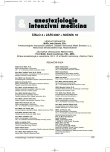Anaesthesia options in carotid endarterectomy
Authors:
Z. Mrozek; J. Koutná; Ondřej Marek
Authors‘ workplace:
Klinika anesteziologie a resuscitace Fakultní nemocnice a Lékařské fakulty Univerzity Palackého, Olomouc
Published in:
Anest. intenziv. Med., 18, 2007, č. 4, s. 202-209
Category:
Anaesthesiology - Original Paper
Overview
Objective:
Carotid endarterectomy is a procedure used for the treatment of partial carotid obstruction. Until recently it was performed under general anaesthesia (GA) but recently cervical plexus block (CB) has been used as an alternative. It enables monitoring of the level of consciousness and motor function of the patient during the surgery and therefore allows early diagnosis and intervention in cerebral hypoxia. The aim of the survey was to compare the two anaesthesia methods intra-operatively and in the early postoperative period.
Setting:
Department of anaesthesiology and intensive care, University Hospital.
Materials and methods:
80 patients who underwent carotid endarterectomy (40 patients under GA, 40 in CB) were assessed. The patients were randomised into the two groups according to the first six digits of their date of birth (YYMMDD): odds to CB and evens to GA. The following variables were monitored: the neurological state, systolic and diastolic blood pressure, heart rate, pharmacological interventions, complications associated with anaesthesia and surgery, patient satisfaction, surgery duration, ICU and hospital length of stay (LOS).
Results:
Hypertension was often present in CB necessitating a pharmacological intervention in 16 patients; in the GA group the BP was less stable and tended to be lower, vasopressor administration was necessary in 15 patients. Length of surgery was almost the same in both groups (CB 90 min, GA 88 min) as was the ICU LOS (CB 3.2 days, GA 3.3 days). The hospital LOS was shorter in the CB group: 7.25 days vs. 7.5 days in the GA group. A carotid bypass by a establishing a shunt during surgery was necessary in 35 GA patients while in the CB patients it was only used in 6 cases.
Conclusion:
Cervical block enables good and inexpensive intra-operative neurological state monitoring, it allows eligibility of patients with co-morbidities and provides better haemodynamic stability.To ensure sufficient cerebral blood flow especially during carotid clamping it is important to maintain sufficiently high mean arterial pressure which is easier using the CB method.
Key words:
carotid endarterectomy – regional anaesthesia – cervical plexus block
Labels
Anaesthesiology, Resuscitation and Inten Intensive Care MedicineArticle was published in
Anaesthesiology and Intensive Care Medicine

2007 Issue 4
Most read in this issue
- Non-heart-beating donors
- The First Registered Anaesthetic Nurse in Czechoslovakia: D. S. Alena Stárková-Palečková
- Notes on the pathophysiology of postoperative delirium
- The early days of ether anaesthesia in Moravia in February 1847
